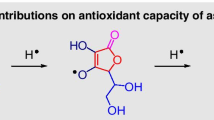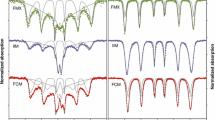Abstract
Complex formation of divalent transition metal ions (copper(II), cobalt(II) and nickel(II)), vitamin B3 (nicotinic acid) and glycine oligopeptides (glycine, glycylglycine, glycyl-l-phenylalanine, and glycylglycylglycine) were studied at 298 K in aqueous solutions using the pH-potentiometric technique. The copper Cu(II), cobalt Co(II), and nickel Ni(II) complexing capacity of vitamin B3 in the absence and in the presence of glycine peptides and their overall stability constants in aqueous solutions were obtained and explained by the HYPERQUAD 2008 program using the potentiometric data. From the protonation and complex formation constants, representative complex species distribution diagrams were obtained using HYSS 2009 software. The UV–Vis spectroscopic, cyclic voltammeteric and conductometric titration measurements were carried out to give qualitative information about the conformation of the complexes formed in these solutions and their stoichiometric ratios. The Gibbs energies and the molecular structures of the complexes were evaluated and predicted using Gaussian 09 software molecular modeling and density functional theory calculations.































Similar content being viewed by others
References
Jacobson, E.L., Kim, H., Kim, M., Jacobson, M.K.: Niacin: vitamin and antidyslipidemic drug. Subcell. Biochem. 56, 37–47 (2012)
Carlson, L.A.: Nicotinic acid: the broad-spectrum lipid drug. A 50th anniversary review. J. Intern. Med. 258, 94–114 (2005)
Gonçalves, E.M., Bernardes, C.E.S., Diogo, H.P., Minas da Piedade, M.E.: Energetics and structure of nicotinic acid (niacin). J. Phys. Chem. B 114, 5475–5485 (2010)
Offermanns, S.: The nicotinic acid receptor GPR109A (HM74A or PUMA-G) as a new therapeutic agent. Trends Pharmacol. Sci. 27, 384–390 (2006)
Lorenzen, A., Stannek, C., Lang, H., Andrianov, V., Kalvinsh, I., Schwabe, U.: Characterization of a G-protein coupled receptor for nicotinic acid. Mol. Pharmacol. 59, 349–357 (2001)
Villines, T.C., Kim, A.S., Gore, R.S., Taylor, A.J.: Niacin: the evidence, clinical use, and future directions. Curr. Atheroscler. Rep. 14, 49–59 (2012)
Wise, A., Foord, S.M., Fraser, N.J., Barnes, A.A., Elshourbagy, N., Eilert, M., Ignar, D.M., Murdock, P.R., Steplewski, K., Green, A., Brown, A.J., Dowell, S.J., Szekeres, P.G., Hassall, D.G., Marshall, F.H., Wilson, S., Pike, N.B.: Molecular identification of high and low affinity receptors for nicotinic acid. J. Biol. Chem. 278, 9869–9874 (2003)
Paolini, J.F., Mitchel, Y.B., Reyes, R., Kher, U., Lai, E., Watson, D.J., Norquist, J.M., Meehan, A.G., Bays, H.E., Davidson, M., Ballantyne, C.M.: Effects of laropiprant on nicotinic acid induced flushing in patients with dyslipidemia. Am. J. Cardiol. 101, 625–630 (2008)
Sakai, T., Kamanna, V.S., Kashyap, M.L.: Niacin, but not gemfibrozil, selectively increases LP-AI, a cardioprotective subfraction of HDL, in patients with low HDL cholesterol. Arterioscler. Thromb. Vasc. Biol. 21, 1783–1789 (2001)
Brown, B.G., Zhao, X.Q., Chait, A., Fisher, L.D., Cheung, M.C., Morse, J.S., Dowdy, A.A., Marino, E.K., Bolson, E.L., Alaupovic, P., Frohlich, J., Albers, J.J.: Simvastatin and niacin, antioxidant vitamins, or the combination for the prevention of coronary disease. New. Engl. J. Med. 345, 1583–1592 (2001)
Angkawijaya, A.E., Fazary, A.E., Hernowo, E., Taha, M., Ju, Y.-H.: Iron(III), chromium(III), and copper(II) complexes of l-norvaline and ferulic acid. J. Chem. Eng. Data 56, 532–540 (2011)
Fazary, A.E., Hernowo, E., Angkawijaya, A.E., Chou, T.-C., Lin, C.H., Taha, M., Ju, Y.-H.: Complex formation between ferric(III), chromium(III) and cupric(II) metal ions and (O, O) donor ligands with biological relevance in aqueous solution. J. Solution Chem. 40, 1965–1986 (2011)
Hernowo, E., Angkawijaya, A.E., Fazary, A.E., Ismadji, S., Ju, Y.H.: Complex stability and molecular structure studies of divalent metal ion with l-norleucine and vitamin B3. J. Chem. Eng. Data 56, 4549–4555 (2011)
Fazary, A.E., Taha, M., Ju, Y.H.: Iron complexation studies of gallic acid. J. Chem. Eng. Data 54, 35–42 (2009)
Angkawijaya, A.E., Fazary, A.E., Ju, Y.H.: Cu(II), Co(II), and Ni(II)-antioxidative phenolates- glycine peptides systems: an insight into its equilibrium solution study. J. Chem. Eng. Data 57, 3443–3451 (2012)
Angkawijaya, A.E., Fazary, A.E., Hernowo, E., Ismadji, S., Ju, Y.H.: Nickel and cobalt complexes of non-protein l-norvaline, and antioxidant ferulic acid: potentiometric and spectrophotometric studies. J. Solution Chem. 7, 1156–1164 (2012)
Metrohm, AG.: Instructions for use for 6.6012.X40 Software TiNet 2.4 CH-9101 Herisau (Switzerland), pp. 1–148
Gans, P., Sabatini, A., Vacca, A.: Investigation of equilibria in solution, determination of equilibrium constants with the HYPERQUAD suite of programs. Talanta 43, 1739–1753 (1996)
Alderighi, L., Gans, P., Ienco, A., Peters, D., Sabatini, A., Vacca, A.: Hyperquad simulation and speciation (HySS): a utility program for the investigation of equilibria involving soluble and partially soluble species. Coord. Chem. Rev. 184, 311–318 (1999)
Frisch, M.J., Trucks, G.W., Schlegel, H.B., Scuseria, G.E., Robb, M.A., Cheeseman, J.R., Scalmani, G., Barone, V., Mennucci, B., Petersson, G.A., Nakatsuji, H., Caricato, M., Li, X., Hratchian, H.P., Izmaylov, A.F., Bloino, J., Zheng, G., Sonnenberg, J.L., Hada, M., Ehara, M., Toyota, K., Fukuda, R., Hasegawa, J., Ishida, M., Nakajima, T., Honda, Y., Kitao, O., Nakai, H., Vreven, T., Montgomery, J.A., Peralta, J.E., Ogliaro, F., Bearpark, M., Heyd, J.J., Brothers, E., Kudin, K.N., Staroverov, V.N., Kobayashi, R., Normand, J., Raghavachari, K., Rendell, A., Burant, J.C., Iyengar, S.S., Tomasi, J., Cossi, M., rega, N., Millam, J.M., Klene, M., Knox, J.E., Cross, J.B., Bakken, V., Adamo, C., Jaramillo, J., Gomperts, R., Stratmann, R. E., Yazyev, O., Austin, A.J., Cammi, R., Pomelli, C., Ochterski, J.W., Martin, E.L., Morokuma, K., Zakrzewski, V.G., Voth, G.A., Salvador, P., Dannenberg, J.J., Dapprich, S., Daniels, A.D., Farkas, O., Foresman, J.B., Ortiz, J.V., Cioslowski, J., Fox, D.J.: Gaussian 09 edn. Gaussian Inc., Wallingford (2009)
Becke, A.D.: Density-functional thermochemistry. III. The role of exact exchange. J. Chem. Phys. 98, 5648–5652 (1993)
Lee, C., Yang, W., Parr, R.G.: Development of the Colle–Salvetti correlation-energy formula into a functional of the electron density. Phys. Rev. B 37, 785–789 (1998)
Rassolov, V.A., Pople, J.A., Ratner, M.A., Windus, T.L.: 6-31G* basis set for atoms K through Zn. J. Chem. Phys. 109, 1223–1229 (1998)
Ramos, J.M., Versiane, O.J.F., Soto, C.A.T.: Fourier transform infrared spectrum, vibrational analysis and structural determination of the trans-bis(glycine)nickel(II) complex by means of the RHF/6-311G and DFT:B3LYP/6-31G and 6-311G methods. Spectrochim. Acta Part A 68, 1370–1378 (2007)
Ramos, J.M., Versiane, O., Felcman, J., Soto, C.A.T.: FT-IR vibrational spectrum and DFT:B3LYP/6-31G and B3LYP/6-311G structure and vibrational analysis of glycinate–guanidoacetate nickel(II) complex: [Ni(Gly)(Gaa)]. Spectrochim. Acta Part A 72, 182–189 (2009)
Chachkov, D.V., Mikhailov, O.V.: DFT B3LYP calculation of the spatial structure of Co(II), Ni(II), and Cu(II) template complexes formed in ternary systems metal(II) ion–dithiooxamide–formaldehyde. Russ. J. Inorg. Chem. 54, 1952–1956 (2009)
Kawakami, J., Miyamoto, R., Fukushi, A., Shimozaki, K., Ito, S.: Ab initio molecular orbital study of the complexing behavior of N-ethyl-1naphtalenecarboxamide as fluorescent chemosensors for alkali and alkaline earth metal ions. J. Photochem. Photobiol. A 146, 163–168 (2002)
Gergely, A., Sovago, I., Nagypal, I., Kiraly, R.: Equilibrium relations of alpha-aminoacid mixed complexes of transition metal ions. Inorg. Chim. Acta 6, 435–439 (1972)
Yamauchi, O., Hirano, Y., Nakao, Y., Nakahara, A.: Stability of fused rings in metal chelates. VI. Structures and stability constants of the copper(II) chelates of dipeptides containing glycine and/or β-alanine. Can. J. Chem. 47, 3441–3445 (1969)
Yamauchi, O., Nakao, Y., Nakahara, A.: Stability of fused rings in metal chelates. X. Structures and stability constants of the copper(II) complexes of tripeptides composed of glycine and/or β-alanine. Bull. Chem. Soc. Japan 46, 2119–2124 (1973)
Irving, H., Williams, R.J.P.: The stability of transition-metal complexes. J. Chem. Soc. 75, 3192–3210 (1953)
Pagenkopf, G.K., Margerum, D.W.: Proton-transfer reaction with copper(II)–triglycine (CuH-2L-). J. Am. Chem. Soc. 90, 501–502 (1968)
Basolo, F., Chen, Y.T., Murmann, R.K.: Sterric effects and the stability of complex compounds. IV. The chelating tendencies of C-substituted ethylenediamines with copper(II) and nickel(II) ions. J. Am. Chem. Soc. 76, 956–959 (1954)
Lenarcik, B., Kierzkowska, A.: The influence of alkyl chain length and steric effect on stability constants and extractability of Zn(II) complexes with 1-alkyl-4(5)-methylimidazoles. Sep. Sci. Technol. 39, 3485–3508 (2004)
Sigel, H., Prijs, B., Martin, R.B.: Stability of binary and ternary β-alanine containing dipeptide copper(II) complexes. Inorg. Chim. Acta 56, 45–49 (1981)
Turkel, N., Sahin, C.: Stability of binary and ternary copper(II) complexes with 1,10-phenanthroline, 2,2′-bipyridyl and some α-amino acids in aqueous medium. Chem. Pharm. Bull. 57, 694–699 (2009)
Khade, B.C., Deore, P.M., Arbad, B.R.: Mixed-ligand complex formation of copper(II) with some aminoacids and drug dapsone. Int. J. ChemTech Res. 2, 1036–1041 (2010)
Sharifi, S., Nori-shargha, D., Bahadory, A.: Complexes of thallium(I) and cadmium(II) with dipeptides of l-phenylalanylglycine and glycyl-l-phenylalanine. J. Braz. Chem. Soc. 18, 1011–1016 (2007)
Casale, A., Robertis, A.D., Stefano, C.D., Gianguzza, A., Patane, G., Rigano, C., Sannartano, S.: Thermodynamic parameters for the formation of glycine complexes with magnesium(II), calcium(II), lead(II), manganese(II), cobalt(II), nickel(II), zinc(II) and cadmium(II) at differenr temperatures and ionic strengths, with particular reference to natural fluid conditions. Thermochim. Acta 255, 109–141 (1995)
Erdemgil, F.Z., Sanli, S., Sanli, N., Ozkan, G., Barbosa, J., Guiteras, J., Beltran, J.L.: Determination of pKa values of some hydroxylated benzoic acids in methanol–water binary mixtures by LC methodology and potentiometry. Talanta 72, 489–496 (2007)
Wu, C.D., Lu, C.Z., Zhuang, H.H., Huang, J.S.: Structure and magnetic property of a new 3D nicotinic acid bridged nickel polymer. Z. Anorg. Allg. Chem. 629, 693–696 (2003)
Ahuja, I.S., Singh, R., Rai, C.P.: Complexes of copper(II) with nicotinic acid and some related ligands. Transit. Met. Chem. 2, 257–260 (1977)
Cooper, J.A., Anderson, B.F., Buckley, P.D., Blackwell, L.F.: Structure and biological activity of nitrogen and oxygen coordinated nicotinic acid complexes of chromium. Inorg. Chim. Acta 91, 1–9 (1984)
Abu-Youssef, M.A.M.: Two new 3D network structures: [Cd3(nic)4(N3)2(H2O)] n and [Zn(nic)(N3)]n (nic = nicotinate anion). Polyhedron 24, 1829–1836 (2005)
Pearson, R.J.: Hard and soft acids and bases. J. Am. Chem. Soc. 85, 3533–3539 (1963)
Acknowledgments
This work was supported by King Abdulaziz City for Science and Technology (KACST) through the Project P–S-12-0017.
Author information
Authors and Affiliations
Corresponding author
Appendices
Rights and permissions
About this article
Cite this article
Rajhi, A.Y., Ju, YH., Angkawijaya, A.E. et al. Complex Formation Equilibria and Molecular Structure of Divalent Metal Ions–Vitamin B3–Glycine Oligopeptides Systems. J Solution Chem 42, 2409–2442 (2013). https://doi.org/10.1007/s10953-013-0116-5
Received:
Accepted:
Published:
Issue Date:
DOI: https://doi.org/10.1007/s10953-013-0116-5









